NUR3101 Assignment: Australian and New Zealand PHC Comparison
VerifiedAdded on 2023/06/04
|11
|3053
|369
Report
AI Summary
This report provides a comprehensive comparison of the primary healthcare systems in Australia and New Zealand. It begins by outlining the key strategies employed in both countries, focusing on their approaches to primary healthcare and their goals of improving access and reducing health inequalities. The report then delves into the determinants of health, including social factors like income and education, environmental factors such as hygiene and water quality, and the influence of public health initiatives. A significant portion of the report is dedicated to comparing and contrasting the Australian and New Zealand strategies, highlighting the similarities and differences in their implementation and outcomes. The analysis considers factors affecting the health of individuals, communities, and the broader population, and discusses the implications for nursing practice, emphasizing person-centered and evidence-based solutions that nurses can contribute to in their roles as primary healthcare providers, focusing on illness prevention and health promotion.
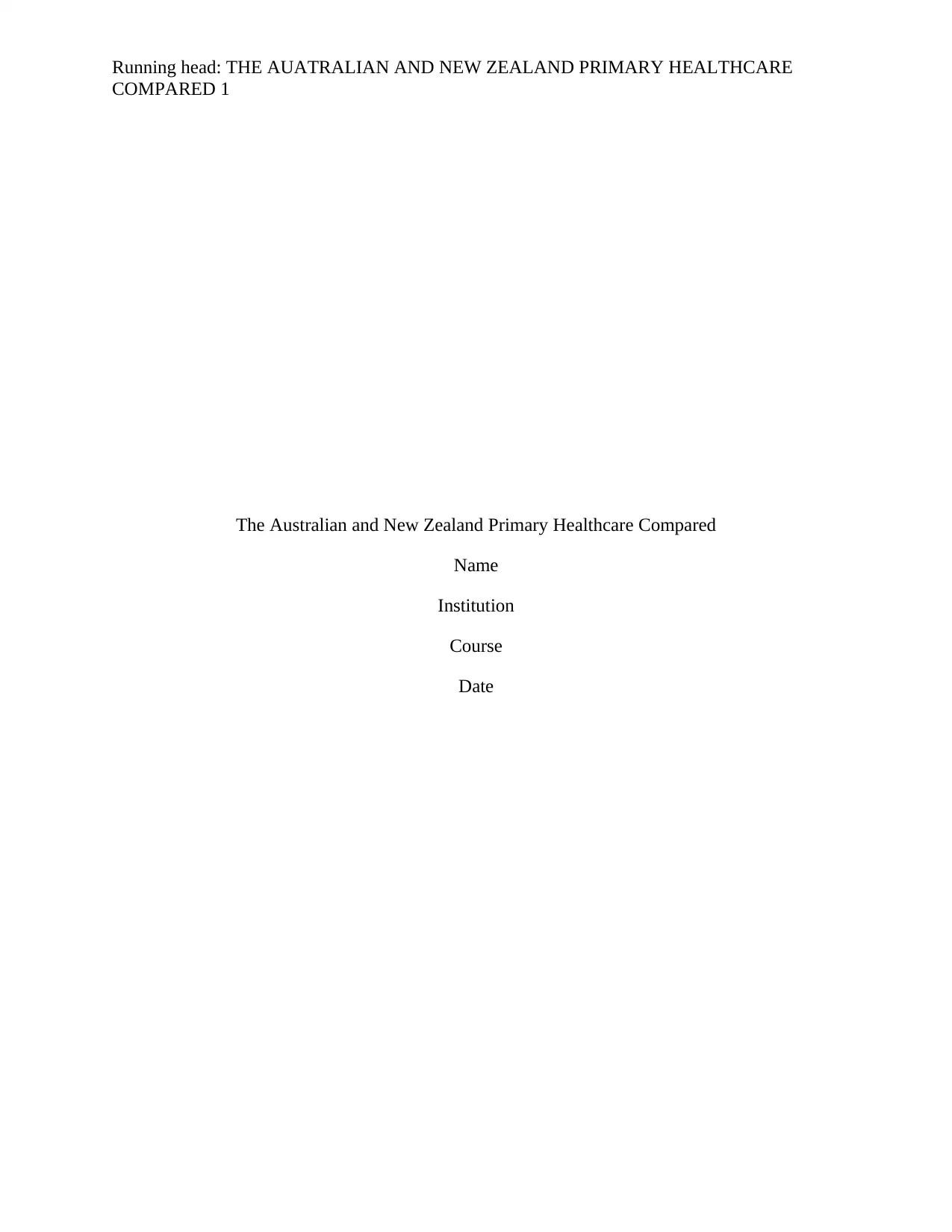
Running head: THE AUATRALIAN AND NEW ZEALAND PRIMARY HEALTHCARE
COMPARED 1
The Australian and New Zealand Primary Healthcare Compared
Name
Institution
Course
Date
COMPARED 1
The Australian and New Zealand Primary Healthcare Compared
Name
Institution
Course
Date
Paraphrase This Document
Need a fresh take? Get an instant paraphrase of this document with our AI Paraphraser
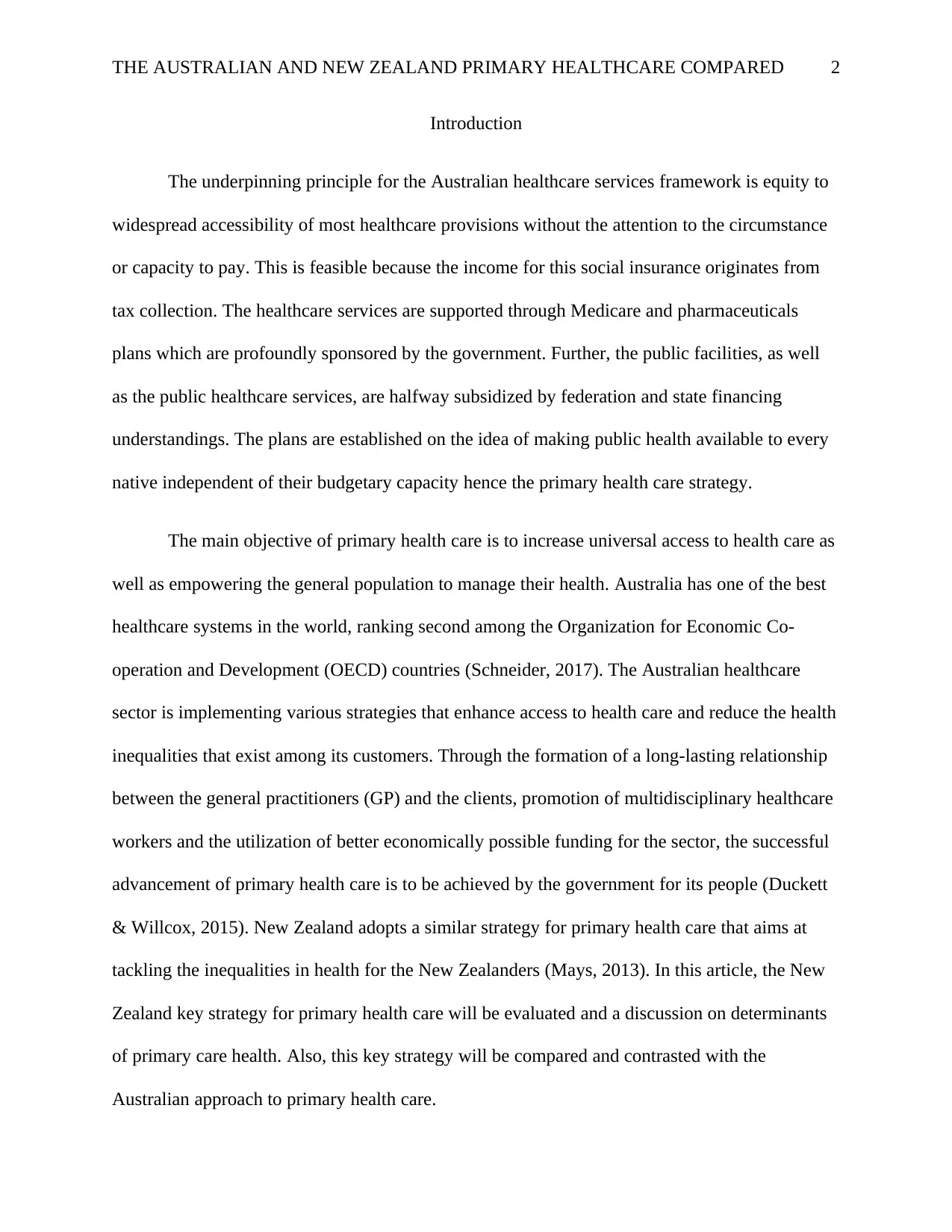
THE AUSTRALIAN AND NEW ZEALAND PRIMARY HEALTHCARE COMPARED 2
Introduction
The underpinning principle for the Australian healthcare services framework is equity to
widespread accessibility of most healthcare provisions without the attention to the circumstance
or capacity to pay. This is feasible because the income for this social insurance originates from
tax collection. The healthcare services are supported through Medicare and pharmaceuticals
plans which are profoundly sponsored by the government. Further, the public facilities, as well
as the public healthcare services, are halfway subsidized by federation and state financing
understandings. The plans are established on the idea of making public health available to every
native independent of their budgetary capacity hence the primary health care strategy.
The main objective of primary health care is to increase universal access to health care as
well as empowering the general population to manage their health. Australia has one of the best
healthcare systems in the world, ranking second among the Organization for Economic Co-
operation and Development (OECD) countries (Schneider, 2017). The Australian healthcare
sector is implementing various strategies that enhance access to health care and reduce the health
inequalities that exist among its customers. Through the formation of a long-lasting relationship
between the general practitioners (GP) and the clients, promotion of multidisciplinary healthcare
workers and the utilization of better economically possible funding for the sector, the successful
advancement of primary health care is to be achieved by the government for its people (Duckett
& Willcox, 2015). New Zealand adopts a similar strategy for primary health care that aims at
tackling the inequalities in health for the New Zealanders (Mays, 2013). In this article, the New
Zealand key strategy for primary health care will be evaluated and a discussion on determinants
of primary care health. Also, this key strategy will be compared and contrasted with the
Australian approach to primary health care.
Introduction
The underpinning principle for the Australian healthcare services framework is equity to
widespread accessibility of most healthcare provisions without the attention to the circumstance
or capacity to pay. This is feasible because the income for this social insurance originates from
tax collection. The healthcare services are supported through Medicare and pharmaceuticals
plans which are profoundly sponsored by the government. Further, the public facilities, as well
as the public healthcare services, are halfway subsidized by federation and state financing
understandings. The plans are established on the idea of making public health available to every
native independent of their budgetary capacity hence the primary health care strategy.
The main objective of primary health care is to increase universal access to health care as
well as empowering the general population to manage their health. Australia has one of the best
healthcare systems in the world, ranking second among the Organization for Economic Co-
operation and Development (OECD) countries (Schneider, 2017). The Australian healthcare
sector is implementing various strategies that enhance access to health care and reduce the health
inequalities that exist among its customers. Through the formation of a long-lasting relationship
between the general practitioners (GP) and the clients, promotion of multidisciplinary healthcare
workers and the utilization of better economically possible funding for the sector, the successful
advancement of primary health care is to be achieved by the government for its people (Duckett
& Willcox, 2015). New Zealand adopts a similar strategy for primary health care that aims at
tackling the inequalities in health for the New Zealanders (Mays, 2013). In this article, the New
Zealand key strategy for primary health care will be evaluated and a discussion on determinants
of primary care health. Also, this key strategy will be compared and contrasted with the
Australian approach to primary health care.
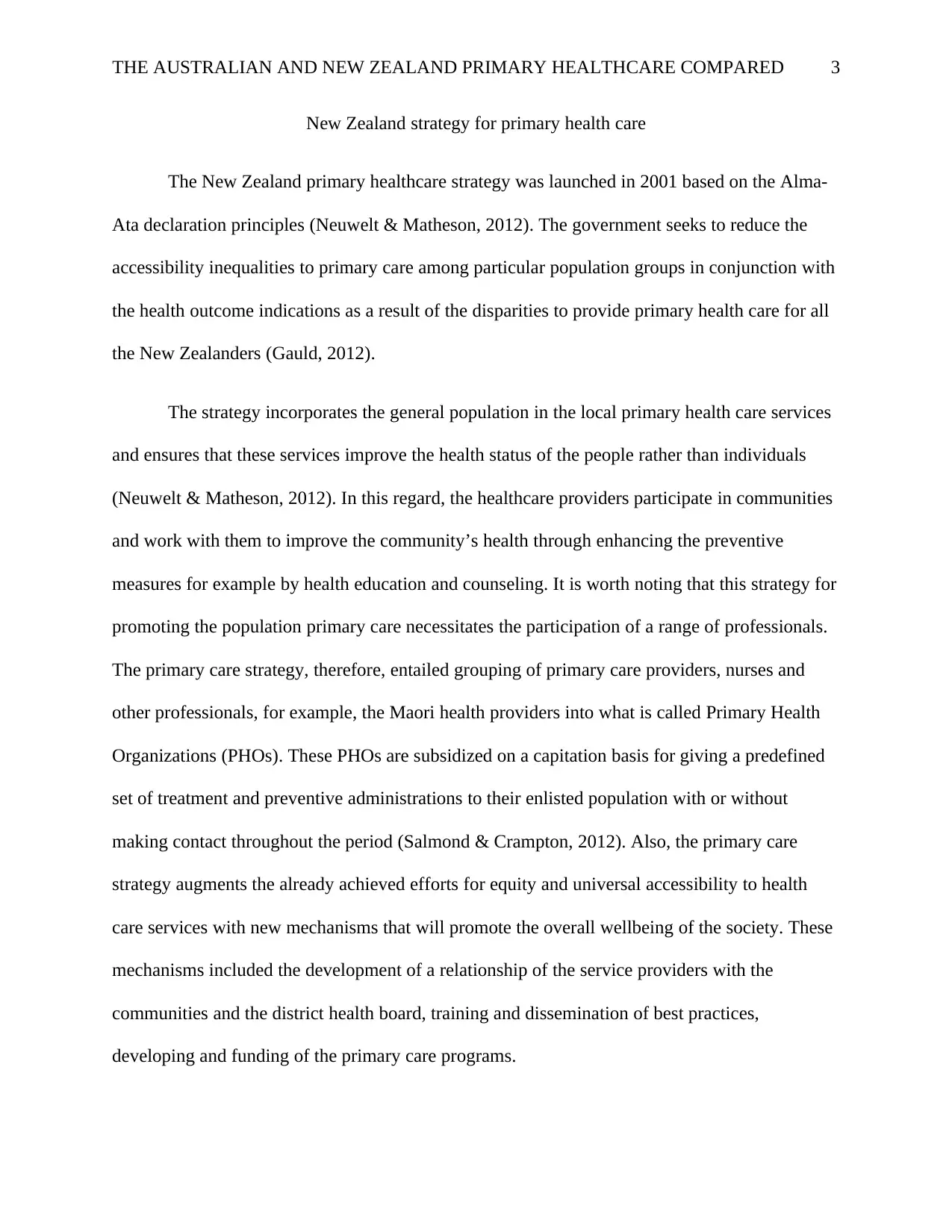
THE AUSTRALIAN AND NEW ZEALAND PRIMARY HEALTHCARE COMPARED 3
New Zealand strategy for primary health care
The New Zealand primary healthcare strategy was launched in 2001 based on the Alma-
Ata declaration principles (Neuwelt & Matheson, 2012). The government seeks to reduce the
accessibility inequalities to primary care among particular population groups in conjunction with
the health outcome indications as a result of the disparities to provide primary health care for all
the New Zealanders (Gauld, 2012).
The strategy incorporates the general population in the local primary health care services
and ensures that these services improve the health status of the people rather than individuals
(Neuwelt & Matheson, 2012). In this regard, the healthcare providers participate in communities
and work with them to improve the community’s health through enhancing the preventive
measures for example by health education and counseling. It is worth noting that this strategy for
promoting the population primary care necessitates the participation of a range of professionals.
The primary care strategy, therefore, entailed grouping of primary care providers, nurses and
other professionals, for example, the Maori health providers into what is called Primary Health
Organizations (PHOs). These PHOs are subsidized on a capitation basis for giving a predefined
set of treatment and preventive administrations to their enlisted population with or without
making contact throughout the period (Salmond & Crampton, 2012). Also, the primary care
strategy augments the already achieved efforts for equity and universal accessibility to health
care services with new mechanisms that will promote the overall wellbeing of the society. These
mechanisms included the development of a relationship of the service providers with the
communities and the district health board, training and dissemination of best practices,
developing and funding of the primary care programs.
New Zealand strategy for primary health care
The New Zealand primary healthcare strategy was launched in 2001 based on the Alma-
Ata declaration principles (Neuwelt & Matheson, 2012). The government seeks to reduce the
accessibility inequalities to primary care among particular population groups in conjunction with
the health outcome indications as a result of the disparities to provide primary health care for all
the New Zealanders (Gauld, 2012).
The strategy incorporates the general population in the local primary health care services
and ensures that these services improve the health status of the people rather than individuals
(Neuwelt & Matheson, 2012). In this regard, the healthcare providers participate in communities
and work with them to improve the community’s health through enhancing the preventive
measures for example by health education and counseling. It is worth noting that this strategy for
promoting the population primary care necessitates the participation of a range of professionals.
The primary care strategy, therefore, entailed grouping of primary care providers, nurses and
other professionals, for example, the Maori health providers into what is called Primary Health
Organizations (PHOs). These PHOs are subsidized on a capitation basis for giving a predefined
set of treatment and preventive administrations to their enlisted population with or without
making contact throughout the period (Salmond & Crampton, 2012). Also, the primary care
strategy augments the already achieved efforts for equity and universal accessibility to health
care services with new mechanisms that will promote the overall wellbeing of the society. These
mechanisms included the development of a relationship of the service providers with the
communities and the district health board, training and dissemination of best practices,
developing and funding of the primary care programs.
⊘ This is a preview!⊘
Do you want full access?
Subscribe today to unlock all pages.

Trusted by 1+ million students worldwide
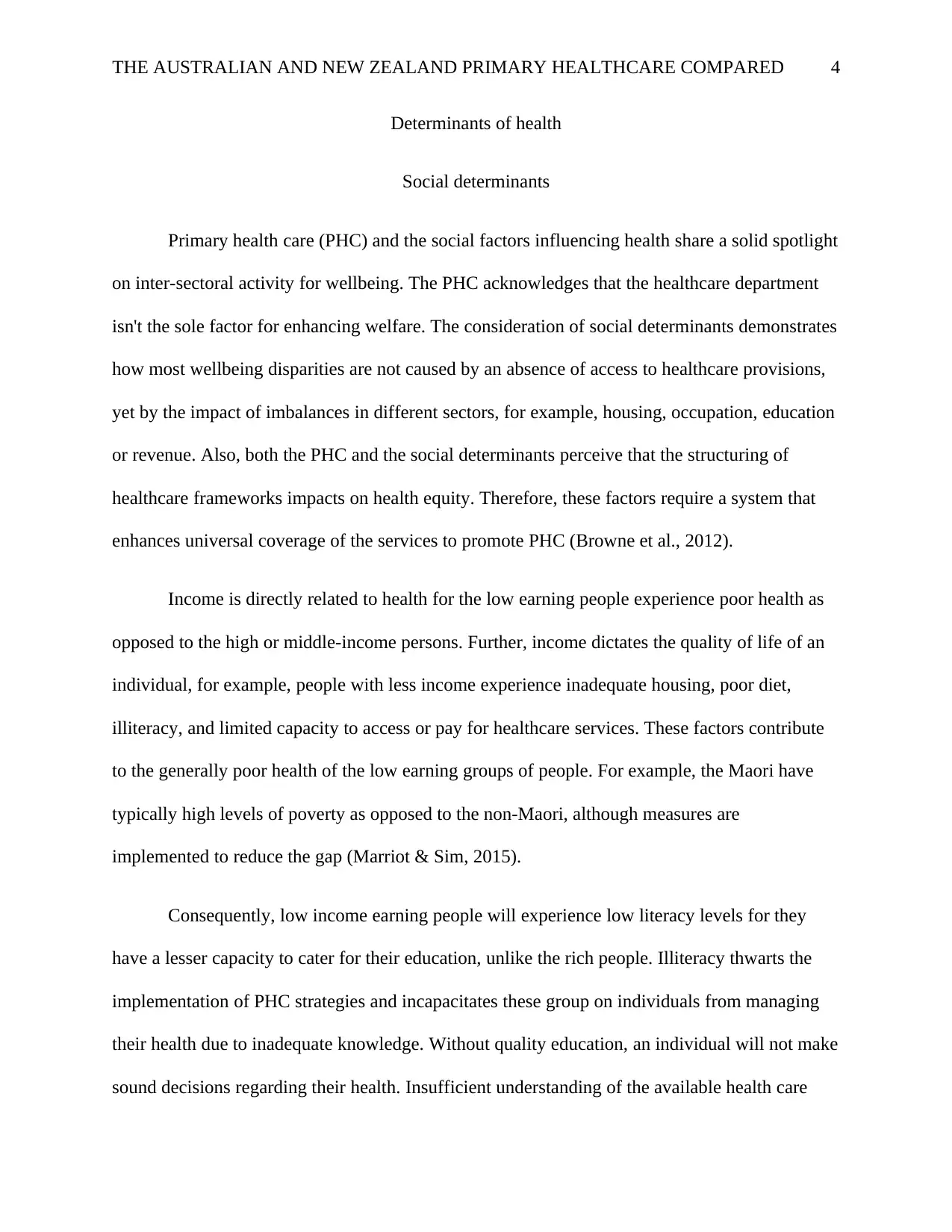
THE AUSTRALIAN AND NEW ZEALAND PRIMARY HEALTHCARE COMPARED 4
Determinants of health
Social determinants
Primary health care (PHC) and the social factors influencing health share a solid spotlight
on inter-sectoral activity for wellbeing. The PHC acknowledges that the healthcare department
isn't the sole factor for enhancing welfare. The consideration of social determinants demonstrates
how most wellbeing disparities are not caused by an absence of access to healthcare provisions,
yet by the impact of imbalances in different sectors, for example, housing, occupation, education
or revenue. Also, both the PHC and the social determinants perceive that the structuring of
healthcare frameworks impacts on health equity. Therefore, these factors require a system that
enhances universal coverage of the services to promote PHC (Browne et al., 2012).
Income is directly related to health for the low earning people experience poor health as
opposed to the high or middle-income persons. Further, income dictates the quality of life of an
individual, for example, people with less income experience inadequate housing, poor diet,
illiteracy, and limited capacity to access or pay for healthcare services. These factors contribute
to the generally poor health of the low earning groups of people. For example, the Maori have
typically high levels of poverty as opposed to the non-Maori, although measures are
implemented to reduce the gap (Marriot & Sim, 2015).
Consequently, low income earning people will experience low literacy levels for they
have a lesser capacity to cater for their education, unlike the rich people. Illiteracy thwarts the
implementation of PHC strategies and incapacitates these group on individuals from managing
their health due to inadequate knowledge. Without quality education, an individual will not make
sound decisions regarding their health. Insufficient understanding of the available health care
Determinants of health
Social determinants
Primary health care (PHC) and the social factors influencing health share a solid spotlight
on inter-sectoral activity for wellbeing. The PHC acknowledges that the healthcare department
isn't the sole factor for enhancing welfare. The consideration of social determinants demonstrates
how most wellbeing disparities are not caused by an absence of access to healthcare provisions,
yet by the impact of imbalances in different sectors, for example, housing, occupation, education
or revenue. Also, both the PHC and the social determinants perceive that the structuring of
healthcare frameworks impacts on health equity. Therefore, these factors require a system that
enhances universal coverage of the services to promote PHC (Browne et al., 2012).
Income is directly related to health for the low earning people experience poor health as
opposed to the high or middle-income persons. Further, income dictates the quality of life of an
individual, for example, people with less income experience inadequate housing, poor diet,
illiteracy, and limited capacity to access or pay for healthcare services. These factors contribute
to the generally poor health of the low earning groups of people. For example, the Maori have
typically high levels of poverty as opposed to the non-Maori, although measures are
implemented to reduce the gap (Marriot & Sim, 2015).
Consequently, low income earning people will experience low literacy levels for they
have a lesser capacity to cater for their education, unlike the rich people. Illiteracy thwarts the
implementation of PHC strategies and incapacitates these group on individuals from managing
their health due to inadequate knowledge. Without quality education, an individual will not make
sound decisions regarding their health. Insufficient understanding of the available health care
Paraphrase This Document
Need a fresh take? Get an instant paraphrase of this document with our AI Paraphraser
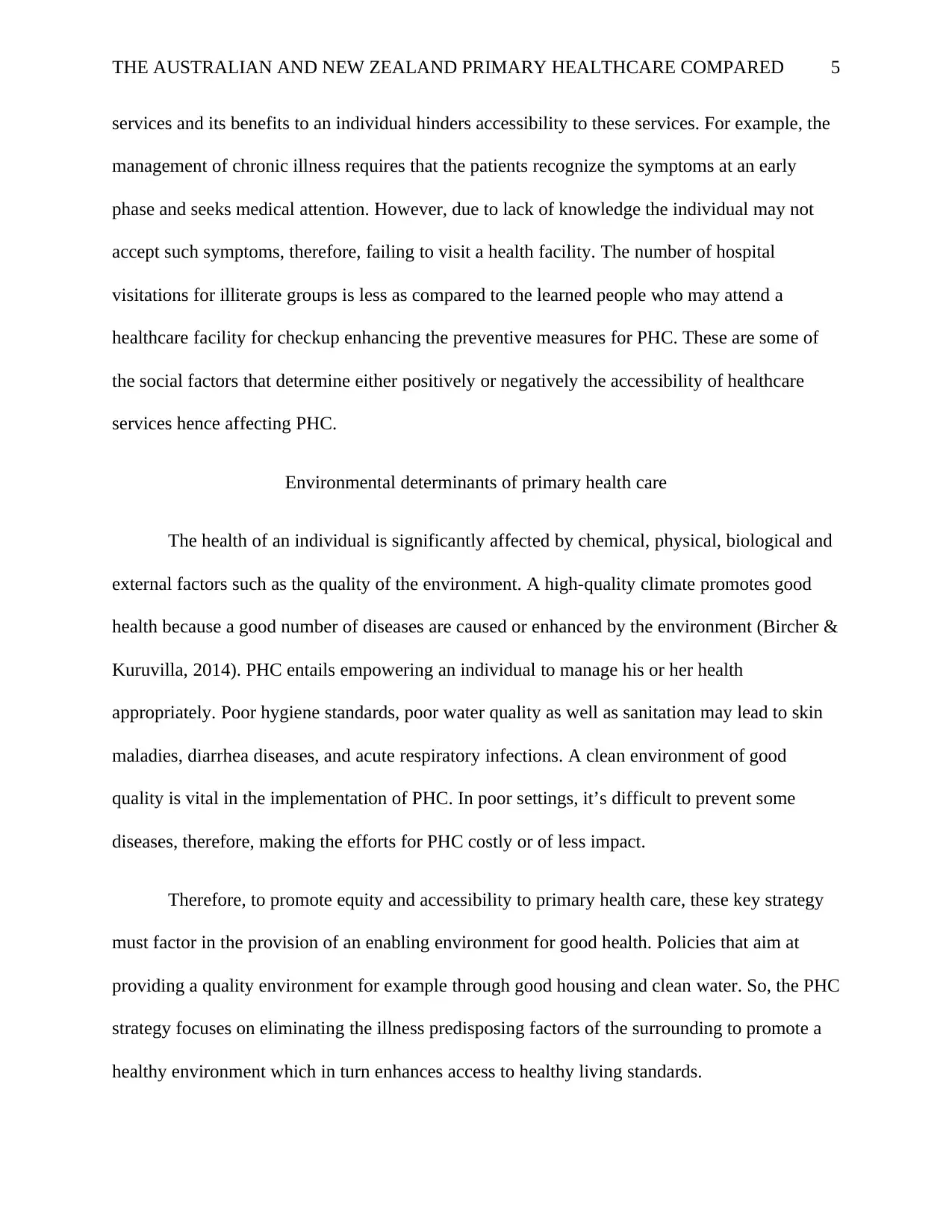
THE AUSTRALIAN AND NEW ZEALAND PRIMARY HEALTHCARE COMPARED 5
services and its benefits to an individual hinders accessibility to these services. For example, the
management of chronic illness requires that the patients recognize the symptoms at an early
phase and seeks medical attention. However, due to lack of knowledge the individual may not
accept such symptoms, therefore, failing to visit a health facility. The number of hospital
visitations for illiterate groups is less as compared to the learned people who may attend a
healthcare facility for checkup enhancing the preventive measures for PHC. These are some of
the social factors that determine either positively or negatively the accessibility of healthcare
services hence affecting PHC.
Environmental determinants of primary health care
The health of an individual is significantly affected by chemical, physical, biological and
external factors such as the quality of the environment. A high-quality climate promotes good
health because a good number of diseases are caused or enhanced by the environment (Bircher &
Kuruvilla, 2014). PHC entails empowering an individual to manage his or her health
appropriately. Poor hygiene standards, poor water quality as well as sanitation may lead to skin
maladies, diarrhea diseases, and acute respiratory infections. A clean environment of good
quality is vital in the implementation of PHC. In poor settings, it’s difficult to prevent some
diseases, therefore, making the efforts for PHC costly or of less impact.
Therefore, to promote equity and accessibility to primary health care, these key strategy
must factor in the provision of an enabling environment for good health. Policies that aim at
providing a quality environment for example through good housing and clean water. So, the PHC
strategy focuses on eliminating the illness predisposing factors of the surrounding to promote a
healthy environment which in turn enhances access to healthy living standards.
services and its benefits to an individual hinders accessibility to these services. For example, the
management of chronic illness requires that the patients recognize the symptoms at an early
phase and seeks medical attention. However, due to lack of knowledge the individual may not
accept such symptoms, therefore, failing to visit a health facility. The number of hospital
visitations for illiterate groups is less as compared to the learned people who may attend a
healthcare facility for checkup enhancing the preventive measures for PHC. These are some of
the social factors that determine either positively or negatively the accessibility of healthcare
services hence affecting PHC.
Environmental determinants of primary health care
The health of an individual is significantly affected by chemical, physical, biological and
external factors such as the quality of the environment. A high-quality climate promotes good
health because a good number of diseases are caused or enhanced by the environment (Bircher &
Kuruvilla, 2014). PHC entails empowering an individual to manage his or her health
appropriately. Poor hygiene standards, poor water quality as well as sanitation may lead to skin
maladies, diarrhea diseases, and acute respiratory infections. A clean environment of good
quality is vital in the implementation of PHC. In poor settings, it’s difficult to prevent some
diseases, therefore, making the efforts for PHC costly or of less impact.
Therefore, to promote equity and accessibility to primary health care, these key strategy
must factor in the provision of an enabling environment for good health. Policies that aim at
providing a quality environment for example through good housing and clean water. So, the PHC
strategy focuses on eliminating the illness predisposing factors of the surrounding to promote a
healthy environment which in turn enhances access to healthy living standards.
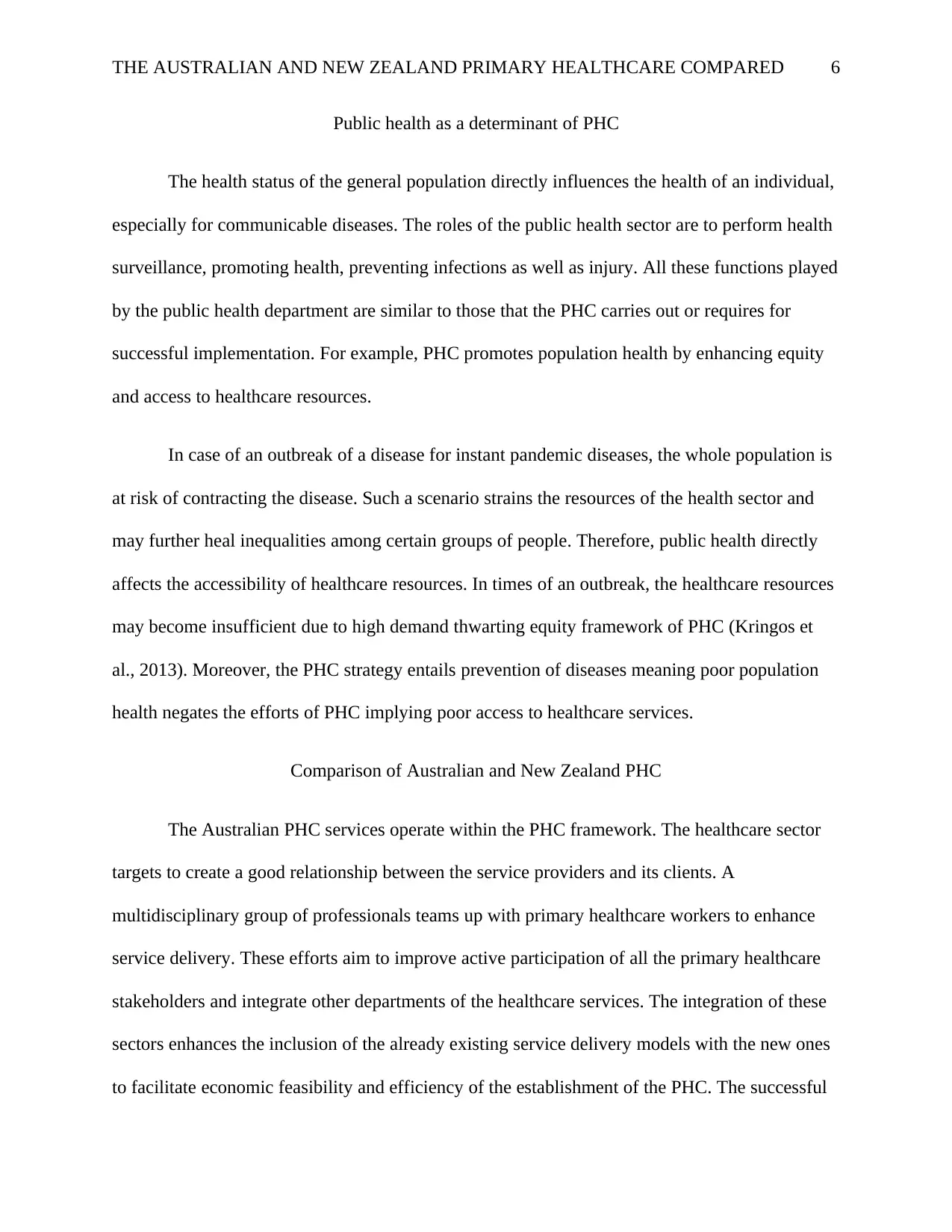
THE AUSTRALIAN AND NEW ZEALAND PRIMARY HEALTHCARE COMPARED 6
Public health as a determinant of PHC
The health status of the general population directly influences the health of an individual,
especially for communicable diseases. The roles of the public health sector are to perform health
surveillance, promoting health, preventing infections as well as injury. All these functions played
by the public health department are similar to those that the PHC carries out or requires for
successful implementation. For example, PHC promotes population health by enhancing equity
and access to healthcare resources.
In case of an outbreak of a disease for instant pandemic diseases, the whole population is
at risk of contracting the disease. Such a scenario strains the resources of the health sector and
may further heal inequalities among certain groups of people. Therefore, public health directly
affects the accessibility of healthcare resources. In times of an outbreak, the healthcare resources
may become insufficient due to high demand thwarting equity framework of PHC (Kringos et
al., 2013). Moreover, the PHC strategy entails prevention of diseases meaning poor population
health negates the efforts of PHC implying poor access to healthcare services.
Comparison of Australian and New Zealand PHC
The Australian PHC services operate within the PHC framework. The healthcare sector
targets to create a good relationship between the service providers and its clients. A
multidisciplinary group of professionals teams up with primary healthcare workers to enhance
service delivery. These efforts aim to improve active participation of all the primary healthcare
stakeholders and integrate other departments of the healthcare services. The integration of these
sectors enhances the inclusion of the already existing service delivery models with the new ones
to facilitate economic feasibility and efficiency of the establishment of the PHC. The successful
Public health as a determinant of PHC
The health status of the general population directly influences the health of an individual,
especially for communicable diseases. The roles of the public health sector are to perform health
surveillance, promoting health, preventing infections as well as injury. All these functions played
by the public health department are similar to those that the PHC carries out or requires for
successful implementation. For example, PHC promotes population health by enhancing equity
and access to healthcare resources.
In case of an outbreak of a disease for instant pandemic diseases, the whole population is
at risk of contracting the disease. Such a scenario strains the resources of the health sector and
may further heal inequalities among certain groups of people. Therefore, public health directly
affects the accessibility of healthcare resources. In times of an outbreak, the healthcare resources
may become insufficient due to high demand thwarting equity framework of PHC (Kringos et
al., 2013). Moreover, the PHC strategy entails prevention of diseases meaning poor population
health negates the efforts of PHC implying poor access to healthcare services.
Comparison of Australian and New Zealand PHC
The Australian PHC services operate within the PHC framework. The healthcare sector
targets to create a good relationship between the service providers and its clients. A
multidisciplinary group of professionals teams up with primary healthcare workers to enhance
service delivery. These efforts aim to improve active participation of all the primary healthcare
stakeholders and integrate other departments of the healthcare services. The integration of these
sectors enhances the inclusion of the already existing service delivery models with the new ones
to facilitate economic feasibility and efficiency of the establishment of the PHC. The successful
⊘ This is a preview!⊘
Do you want full access?
Subscribe today to unlock all pages.

Trusted by 1+ million students worldwide
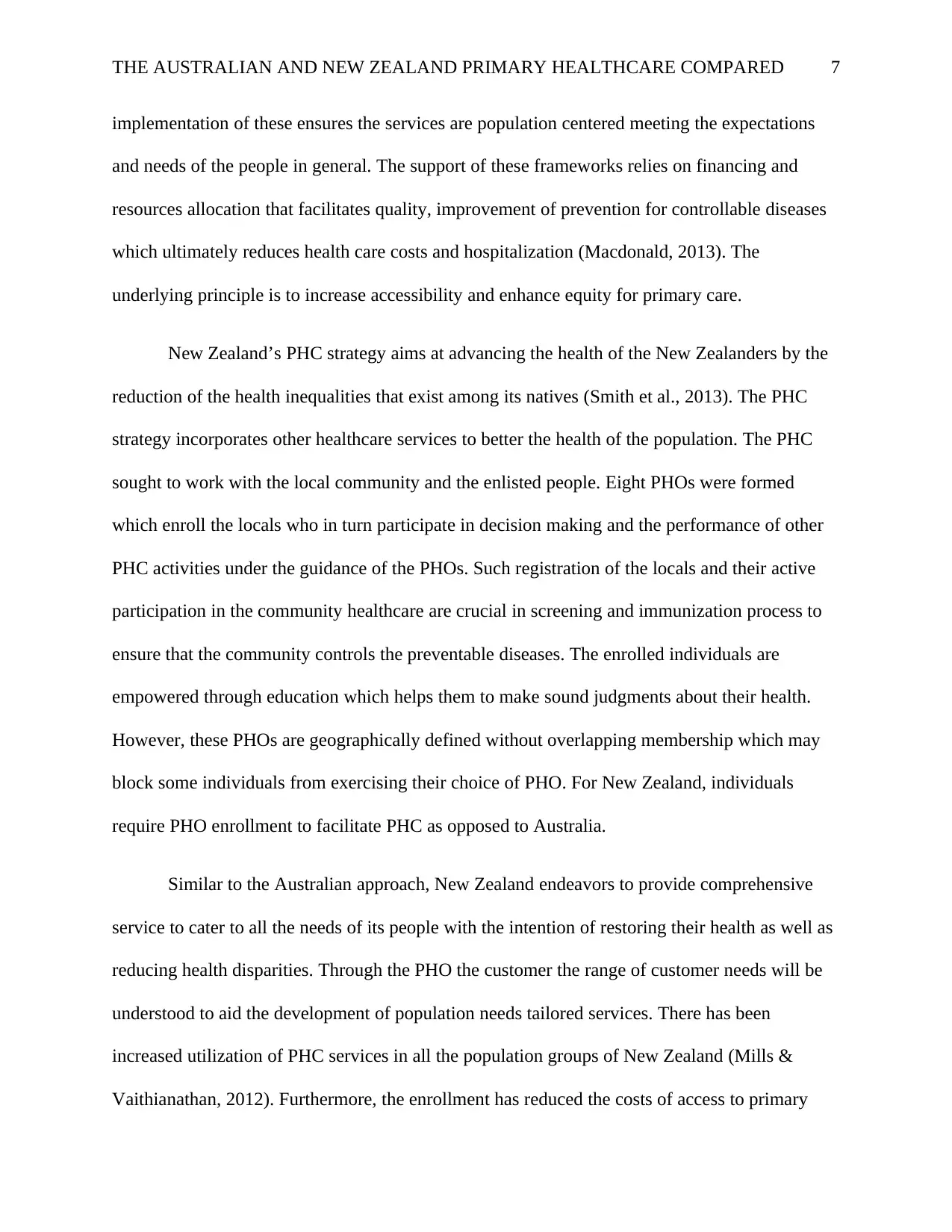
THE AUSTRALIAN AND NEW ZEALAND PRIMARY HEALTHCARE COMPARED 7
implementation of these ensures the services are population centered meeting the expectations
and needs of the people in general. The support of these frameworks relies on financing and
resources allocation that facilitates quality, improvement of prevention for controllable diseases
which ultimately reduces health care costs and hospitalization (Macdonald, 2013). The
underlying principle is to increase accessibility and enhance equity for primary care.
New Zealand’s PHC strategy aims at advancing the health of the New Zealanders by the
reduction of the health inequalities that exist among its natives (Smith et al., 2013). The PHC
strategy incorporates other healthcare services to better the health of the population. The PHC
sought to work with the local community and the enlisted people. Eight PHOs were formed
which enroll the locals who in turn participate in decision making and the performance of other
PHC activities under the guidance of the PHOs. Such registration of the locals and their active
participation in the community healthcare are crucial in screening and immunization process to
ensure that the community controls the preventable diseases. The enrolled individuals are
empowered through education which helps them to make sound judgments about their health.
However, these PHOs are geographically defined without overlapping membership which may
block some individuals from exercising their choice of PHO. For New Zealand, individuals
require PHO enrollment to facilitate PHC as opposed to Australia.
Similar to the Australian approach, New Zealand endeavors to provide comprehensive
service to cater to all the needs of its people with the intention of restoring their health as well as
reducing health disparities. Through the PHO the customer the range of customer needs will be
understood to aid the development of population needs tailored services. There has been
increased utilization of PHC services in all the population groups of New Zealand (Mills &
Vaithianathan, 2012). Furthermore, the enrollment has reduced the costs of access to primary
implementation of these ensures the services are population centered meeting the expectations
and needs of the people in general. The support of these frameworks relies on financing and
resources allocation that facilitates quality, improvement of prevention for controllable diseases
which ultimately reduces health care costs and hospitalization (Macdonald, 2013). The
underlying principle is to increase accessibility and enhance equity for primary care.
New Zealand’s PHC strategy aims at advancing the health of the New Zealanders by the
reduction of the health inequalities that exist among its natives (Smith et al., 2013). The PHC
strategy incorporates other healthcare services to better the health of the population. The PHC
sought to work with the local community and the enlisted people. Eight PHOs were formed
which enroll the locals who in turn participate in decision making and the performance of other
PHC activities under the guidance of the PHOs. Such registration of the locals and their active
participation in the community healthcare are crucial in screening and immunization process to
ensure that the community controls the preventable diseases. The enrolled individuals are
empowered through education which helps them to make sound judgments about their health.
However, these PHOs are geographically defined without overlapping membership which may
block some individuals from exercising their choice of PHO. For New Zealand, individuals
require PHO enrollment to facilitate PHC as opposed to Australia.
Similar to the Australian approach, New Zealand endeavors to provide comprehensive
service to cater to all the needs of its people with the intention of restoring their health as well as
reducing health disparities. Through the PHO the customer the range of customer needs will be
understood to aid the development of population needs tailored services. There has been
increased utilization of PHC services in all the population groups of New Zealand (Mills &
Vaithianathan, 2012). Furthermore, the enrollment has reduced the costs of access to primary
Paraphrase This Document
Need a fresh take? Get an instant paraphrase of this document with our AI Paraphraser
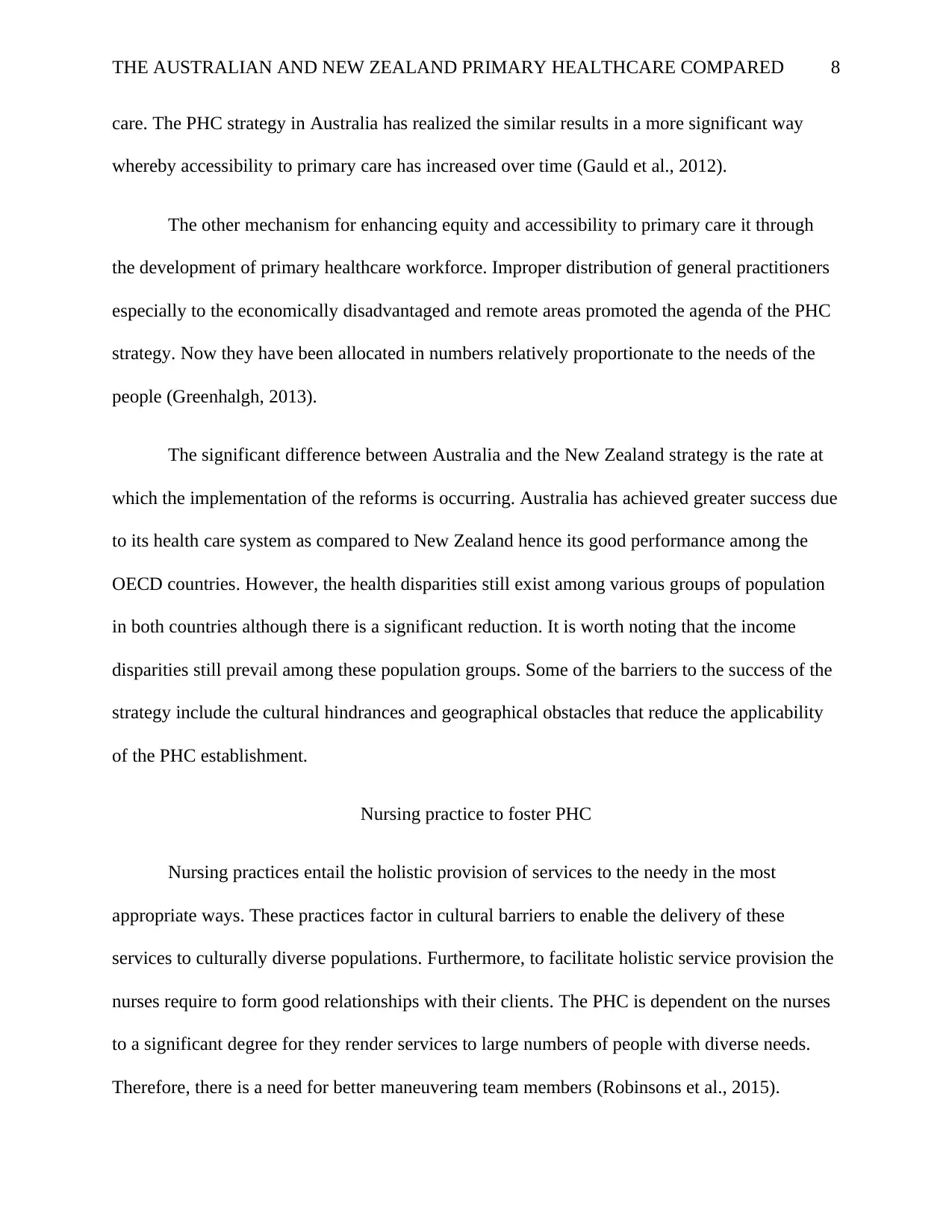
THE AUSTRALIAN AND NEW ZEALAND PRIMARY HEALTHCARE COMPARED 8
care. The PHC strategy in Australia has realized the similar results in a more significant way
whereby accessibility to primary care has increased over time (Gauld et al., 2012).
The other mechanism for enhancing equity and accessibility to primary care it through
the development of primary healthcare workforce. Improper distribution of general practitioners
especially to the economically disadvantaged and remote areas promoted the agenda of the PHC
strategy. Now they have been allocated in numbers relatively proportionate to the needs of the
people (Greenhalgh, 2013).
The significant difference between Australia and the New Zealand strategy is the rate at
which the implementation of the reforms is occurring. Australia has achieved greater success due
to its health care system as compared to New Zealand hence its good performance among the
OECD countries. However, the health disparities still exist among various groups of population
in both countries although there is a significant reduction. It is worth noting that the income
disparities still prevail among these population groups. Some of the barriers to the success of the
strategy include the cultural hindrances and geographical obstacles that reduce the applicability
of the PHC establishment.
Nursing practice to foster PHC
Nursing practices entail the holistic provision of services to the needy in the most
appropriate ways. These practices factor in cultural barriers to enable the delivery of these
services to culturally diverse populations. Furthermore, to facilitate holistic service provision the
nurses require to form good relationships with their clients. The PHC is dependent on the nurses
to a significant degree for they render services to large numbers of people with diverse needs.
Therefore, there is a need for better maneuvering team members (Robinsons et al., 2015).
care. The PHC strategy in Australia has realized the similar results in a more significant way
whereby accessibility to primary care has increased over time (Gauld et al., 2012).
The other mechanism for enhancing equity and accessibility to primary care it through
the development of primary healthcare workforce. Improper distribution of general practitioners
especially to the economically disadvantaged and remote areas promoted the agenda of the PHC
strategy. Now they have been allocated in numbers relatively proportionate to the needs of the
people (Greenhalgh, 2013).
The significant difference between Australia and the New Zealand strategy is the rate at
which the implementation of the reforms is occurring. Australia has achieved greater success due
to its health care system as compared to New Zealand hence its good performance among the
OECD countries. However, the health disparities still exist among various groups of population
in both countries although there is a significant reduction. It is worth noting that the income
disparities still prevail among these population groups. Some of the barriers to the success of the
strategy include the cultural hindrances and geographical obstacles that reduce the applicability
of the PHC establishment.
Nursing practice to foster PHC
Nursing practices entail the holistic provision of services to the needy in the most
appropriate ways. These practices factor in cultural barriers to enable the delivery of these
services to culturally diverse populations. Furthermore, to facilitate holistic service provision the
nurses require to form good relationships with their clients. The PHC is dependent on the nurses
to a significant degree for they render services to large numbers of people with diverse needs.
Therefore, there is a need for better maneuvering team members (Robinsons et al., 2015).
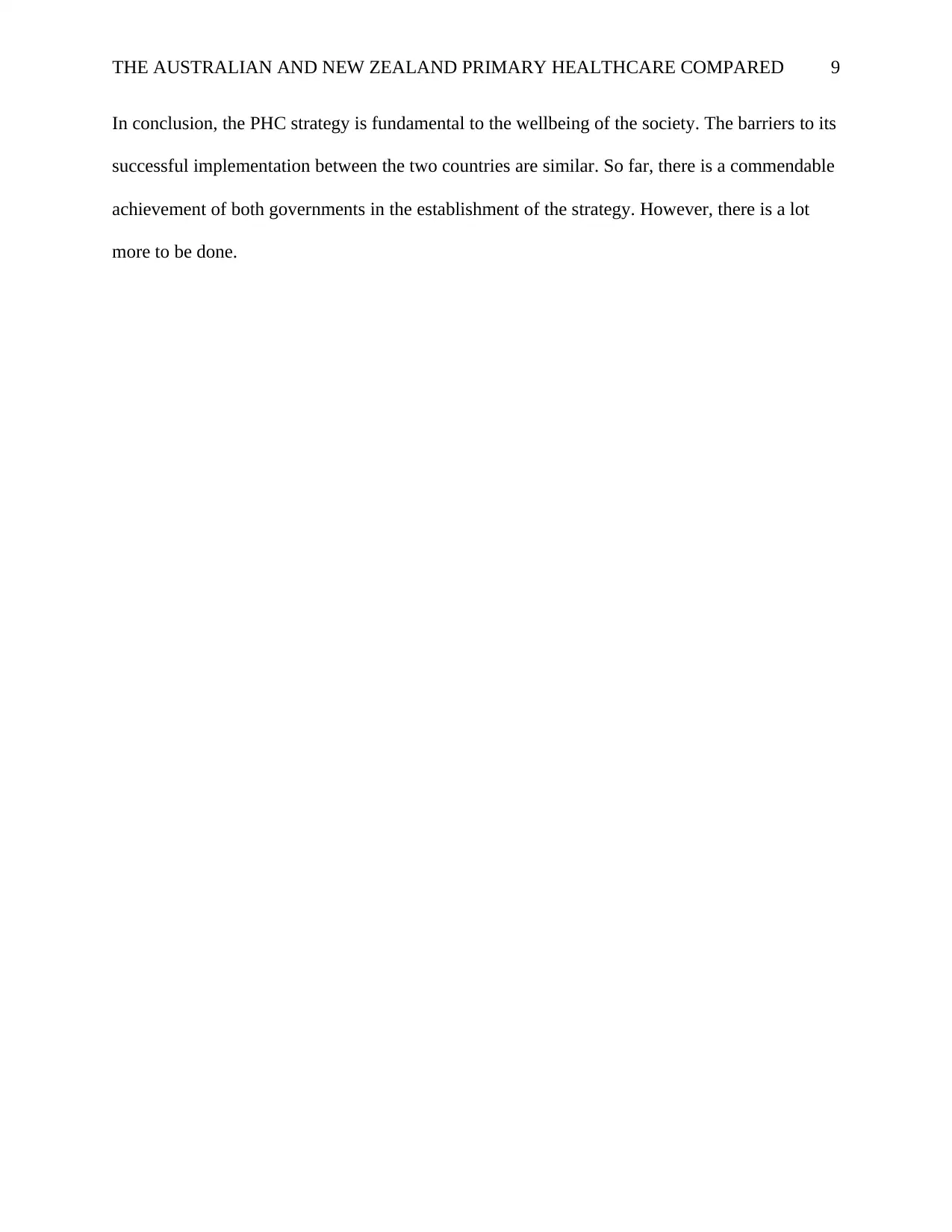
THE AUSTRALIAN AND NEW ZEALAND PRIMARY HEALTHCARE COMPARED 9
In conclusion, the PHC strategy is fundamental to the wellbeing of the society. The barriers to its
successful implementation between the two countries are similar. So far, there is a commendable
achievement of both governments in the establishment of the strategy. However, there is a lot
more to be done.
In conclusion, the PHC strategy is fundamental to the wellbeing of the society. The barriers to its
successful implementation between the two countries are similar. So far, there is a commendable
achievement of both governments in the establishment of the strategy. However, there is a lot
more to be done.
⊘ This is a preview!⊘
Do you want full access?
Subscribe today to unlock all pages.

Trusted by 1+ million students worldwide
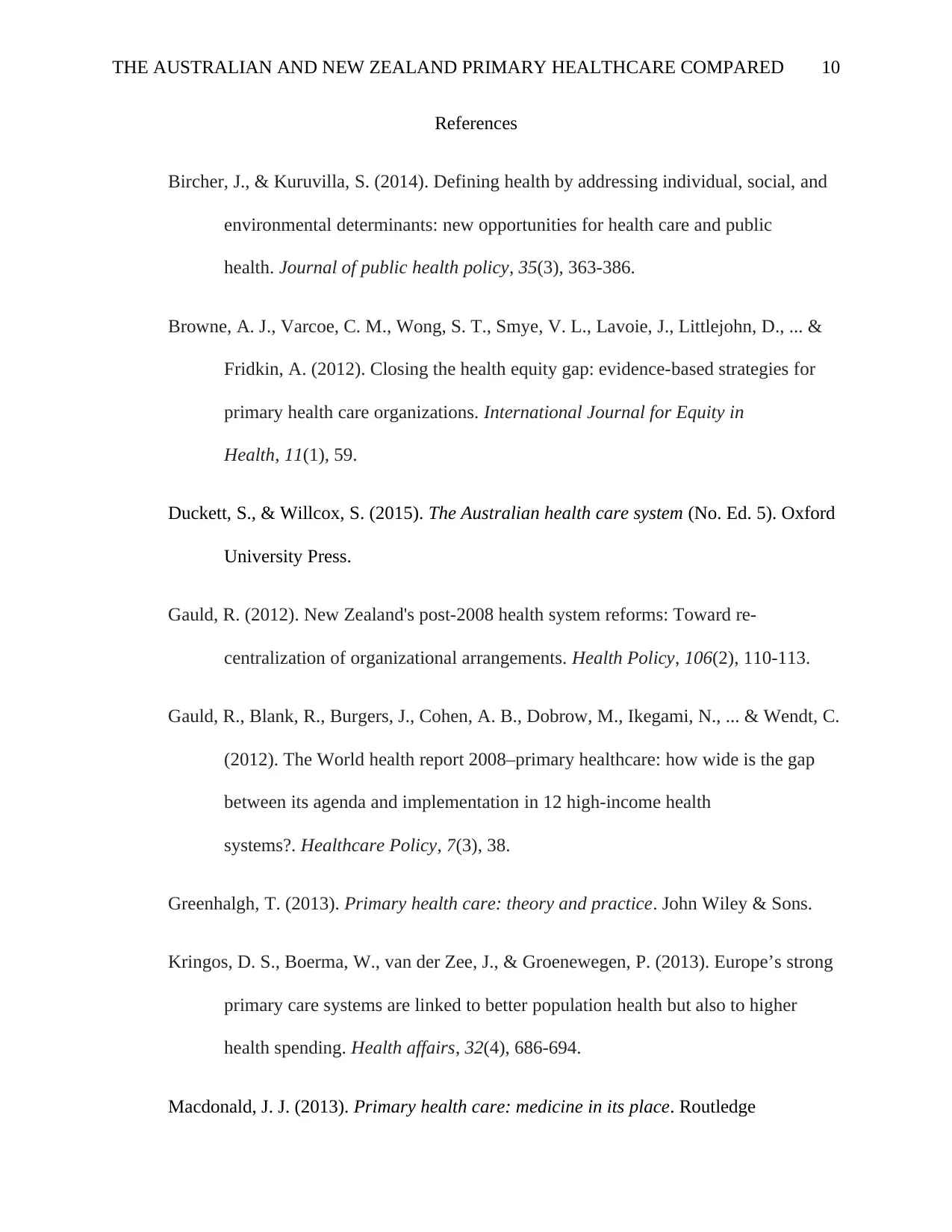
THE AUSTRALIAN AND NEW ZEALAND PRIMARY HEALTHCARE COMPARED 10
References
Bircher, J., & Kuruvilla, S. (2014). Defining health by addressing individual, social, and
environmental determinants: new opportunities for health care and public
health. Journal of public health policy, 35(3), 363-386.
Browne, A. J., Varcoe, C. M., Wong, S. T., Smye, V. L., Lavoie, J., Littlejohn, D., ... &
Fridkin, A. (2012). Closing the health equity gap: evidence-based strategies for
primary health care organizations. International Journal for Equity in
Health, 11(1), 59.
Duckett, S., & Willcox, S. (2015). The Australian health care system (No. Ed. 5). Oxford
University Press.
Gauld, R. (2012). New Zealand's post-2008 health system reforms: Toward re-
centralization of organizational arrangements. Health Policy, 106(2), 110-113.
Gauld, R., Blank, R., Burgers, J., Cohen, A. B., Dobrow, M., Ikegami, N., ... & Wendt, C.
(2012). The World health report 2008–primary healthcare: how wide is the gap
between its agenda and implementation in 12 high-income health
systems?. Healthcare Policy, 7(3), 38.
Greenhalgh, T. (2013). Primary health care: theory and practice. John Wiley & Sons.
Kringos, D. S., Boerma, W., van der Zee, J., & Groenewegen, P. (2013). Europe’s strong
primary care systems are linked to better population health but also to higher
health spending. Health affairs, 32(4), 686-694.
Macdonald, J. J. (2013). Primary health care: medicine in its place. Routledge
References
Bircher, J., & Kuruvilla, S. (2014). Defining health by addressing individual, social, and
environmental determinants: new opportunities for health care and public
health. Journal of public health policy, 35(3), 363-386.
Browne, A. J., Varcoe, C. M., Wong, S. T., Smye, V. L., Lavoie, J., Littlejohn, D., ... &
Fridkin, A. (2012). Closing the health equity gap: evidence-based strategies for
primary health care organizations. International Journal for Equity in
Health, 11(1), 59.
Duckett, S., & Willcox, S. (2015). The Australian health care system (No. Ed. 5). Oxford
University Press.
Gauld, R. (2012). New Zealand's post-2008 health system reforms: Toward re-
centralization of organizational arrangements. Health Policy, 106(2), 110-113.
Gauld, R., Blank, R., Burgers, J., Cohen, A. B., Dobrow, M., Ikegami, N., ... & Wendt, C.
(2012). The World health report 2008–primary healthcare: how wide is the gap
between its agenda and implementation in 12 high-income health
systems?. Healthcare Policy, 7(3), 38.
Greenhalgh, T. (2013). Primary health care: theory and practice. John Wiley & Sons.
Kringos, D. S., Boerma, W., van der Zee, J., & Groenewegen, P. (2013). Europe’s strong
primary care systems are linked to better population health but also to higher
health spending. Health affairs, 32(4), 686-694.
Macdonald, J. J. (2013). Primary health care: medicine in its place. Routledge
Paraphrase This Document
Need a fresh take? Get an instant paraphrase of this document with our AI Paraphraser
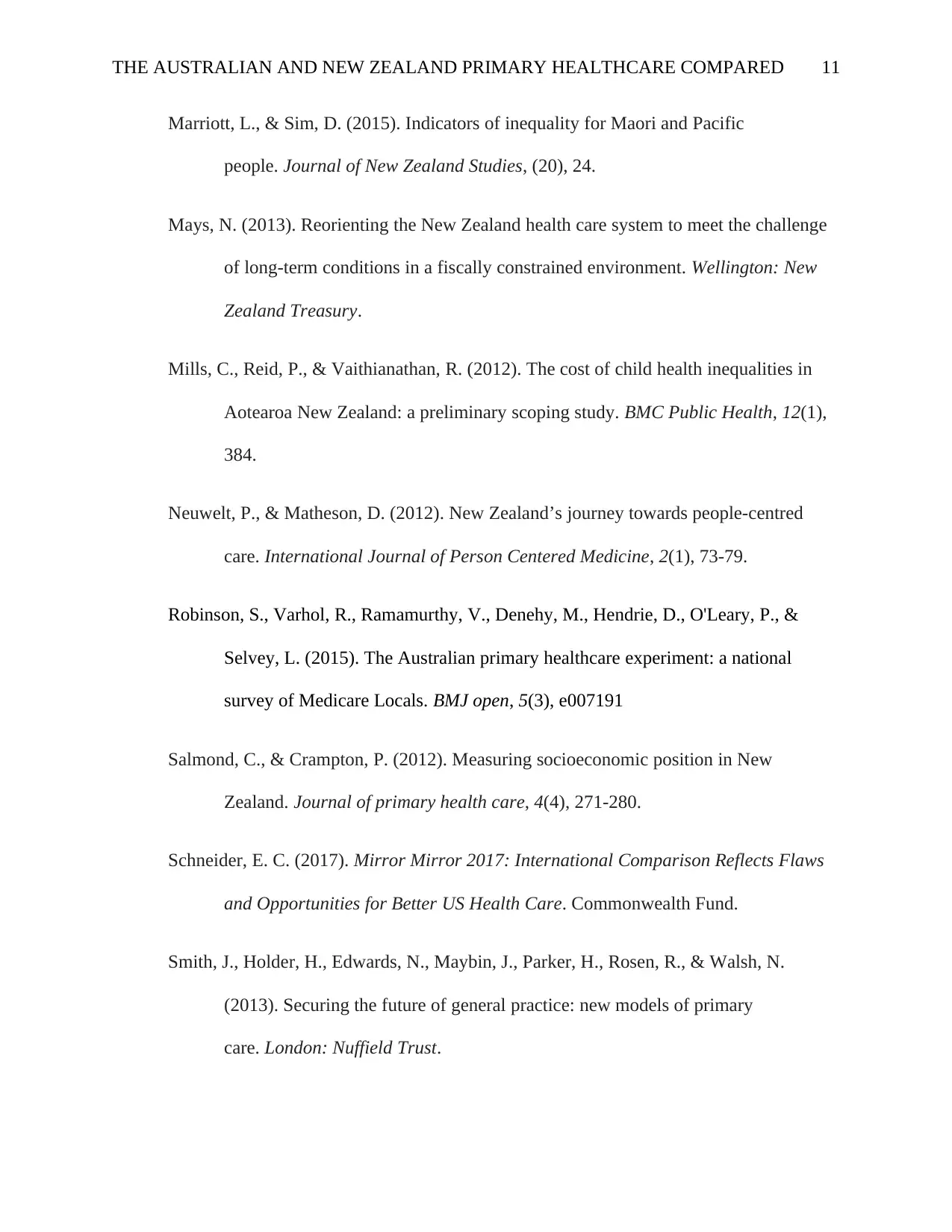
THE AUSTRALIAN AND NEW ZEALAND PRIMARY HEALTHCARE COMPARED 11
Marriott, L., & Sim, D. (2015). Indicators of inequality for Maori and Pacific
people. Journal of New Zealand Studies, (20), 24.
Mays, N. (2013). Reorienting the New Zealand health care system to meet the challenge
of long-term conditions in a fiscally constrained environment. Wellington: New
Zealand Treasury.
Mills, C., Reid, P., & Vaithianathan, R. (2012). The cost of child health inequalities in
Aotearoa New Zealand: a preliminary scoping study. BMC Public Health, 12(1),
384.
Neuwelt, P., & Matheson, D. (2012). New Zealand’s journey towards people-centred
care. International Journal of Person Centered Medicine, 2(1), 73-79.
Robinson, S., Varhol, R., Ramamurthy, V., Denehy, M., Hendrie, D., O'Leary, P., &
Selvey, L. (2015). The Australian primary healthcare experiment: a national
survey of Medicare Locals. BMJ open, 5(3), e007191
Salmond, C., & Crampton, P. (2012). Measuring socioeconomic position in New
Zealand. Journal of primary health care, 4(4), 271-280.
Schneider, E. C. (2017). Mirror Mirror 2017: International Comparison Reflects Flaws
and Opportunities for Better US Health Care. Commonwealth Fund.
Smith, J., Holder, H., Edwards, N., Maybin, J., Parker, H., Rosen, R., & Walsh, N.
(2013). Securing the future of general practice: new models of primary
care. London: Nuffield Trust.
Marriott, L., & Sim, D. (2015). Indicators of inequality for Maori and Pacific
people. Journal of New Zealand Studies, (20), 24.
Mays, N. (2013). Reorienting the New Zealand health care system to meet the challenge
of long-term conditions in a fiscally constrained environment. Wellington: New
Zealand Treasury.
Mills, C., Reid, P., & Vaithianathan, R. (2012). The cost of child health inequalities in
Aotearoa New Zealand: a preliminary scoping study. BMC Public Health, 12(1),
384.
Neuwelt, P., & Matheson, D. (2012). New Zealand’s journey towards people-centred
care. International Journal of Person Centered Medicine, 2(1), 73-79.
Robinson, S., Varhol, R., Ramamurthy, V., Denehy, M., Hendrie, D., O'Leary, P., &
Selvey, L. (2015). The Australian primary healthcare experiment: a national
survey of Medicare Locals. BMJ open, 5(3), e007191
Salmond, C., & Crampton, P. (2012). Measuring socioeconomic position in New
Zealand. Journal of primary health care, 4(4), 271-280.
Schneider, E. C. (2017). Mirror Mirror 2017: International Comparison Reflects Flaws
and Opportunities for Better US Health Care. Commonwealth Fund.
Smith, J., Holder, H., Edwards, N., Maybin, J., Parker, H., Rosen, R., & Walsh, N.
(2013). Securing the future of general practice: new models of primary
care. London: Nuffield Trust.
1 out of 11
Related Documents
Your All-in-One AI-Powered Toolkit for Academic Success.
+13062052269
info@desklib.com
Available 24*7 on WhatsApp / Email
![[object Object]](/_next/static/media/star-bottom.7253800d.svg)
Unlock your academic potential
Copyright © 2020–2025 A2Z Services. All Rights Reserved. Developed and managed by ZUCOL.





